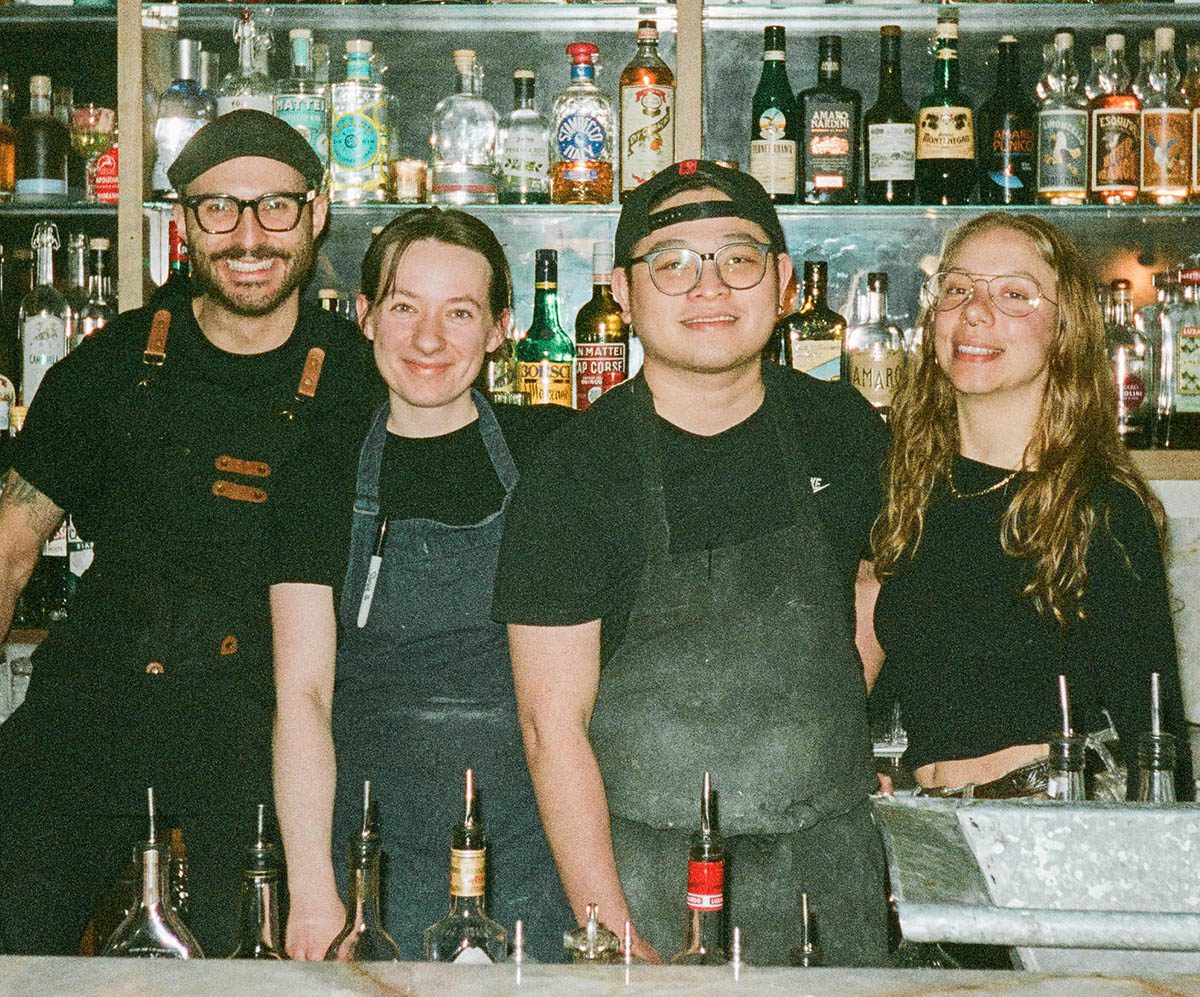By Laura Pratt
Years from now, historians, looking back on this period in human history in pursuit of, say, a picture of our economic and social well-being, might hone in on Ontario’s restaurant industry, which offers a microcosmic view into our collective psyche during this patch of the still early, but post-COVID 21st century.
It’s in this snatch of history that we find society struggling to find its footing in an environment still doubled over from a pandemic amidst soaring costs, including an expensive labour and real-estate market. And in this province, Canada’s most populous, we see reflected the general state of mind for a population that bent itself to societal constraints so vigorously that the knots remain to this day.
With the pent-up demand for on-premise restaurant experiences following the restrictions of the pandemic spent, consumers are settling into a new normal that’s less reactionary to the physical health of the population and more reactionary to its economic health.
“I would say [the Ontario restaurant industry] is in very tough shape,” says Ryan Mallough, vice-president of Legislative Affairs for Ontario, Canadian Federation of Independent Businesses (CFIB). “It’s a sector that really hasn’t recovered from those three years of closing.”
To wit, the industry has endured a 100-per-cent growth in bankruptcies over the last year — most in the full-service segment.
“We continue to get price increases from our suppliers, and they think we can absorb them,” says Domenic Primucci, president of Pizza Nova. “We can’t. That’s why restaurants aren’t making money. They don’t want to price themselves to the point that customers won’t come. But it’s already happening. Customers aren’t coming.”
It explains why 65 per cent of Ontario restaurants aren’t making a profit right now; in 2019, just 12 per cent weren’t profitable.
“This is a real problem here in Ontario because the margins restaurants make are under five per cent,” says Primucci. “And [with so many] not making money, it’s very easy to be in the red here. One small thing, one repair could put you in trouble.”
It would also be easy not to see the scene’s woes, given that the industry’s every sector is exceeding the numbers generated in 2019. But, says Tony Elenis, president and CEO of the Ontario Restaurant, Hotel and Motel Association, “that doesn’t flow through to the bottom line because of the increased expenses, especially in food purchasing, which make up over 35 per cent of all purchases in a typical restaurant. Then over and above that, you have the price of labour going up.”
Labour now accounts for a quarter of total costs rather than a fifth, as it conventionally has.
Flagging Optimism
It’s thanks to these price hikes, says Mallough, that “customers who used to come two or three times a week are now coming once.
“Those downtown sit-down restaurants in the major centres also had the hit of their clientele’s commuting patterns changing dramatically. They’re still figuring out how to adjust. That’s a real challenge. Optimism in the industry remains very low this year, well behind its historical average, so it’s going to be a struggle.”
Indeed, says Ken Otto, CEO of Redberry Restaurants, whose Burger King, Taco Bell, and Jersey Mikes holdings might make it the biggest restaurant owner in the country. The level of optimism that permeated Ontario’s restaurant industry in late 2022 and 2023 isn’t so prevalent anymore. “Things have turned more cautious in the past couple of months,” he says. “The cost of living is catching up to people. Interest rates, mortgage renewals, rents in Toronto, the price of gas, et cetera. The [Ontario restaurant industry] is coming off a relatively buoyant period after the pandemic. It’s pivoting. People are looking for value. They’re interested in eating out — they have established behaviours. But they’re cautious.”
It’s why Redberry is re-visiting its menu and promotional strategies with an eye on value. “We’re telling our guest we understand the cost of living is high these days,” says Otto.
Value’s the ticket, agrees Steven Molnar, partner and executive chef at Quetzal, an elevated Mexican restaurant in Toronto. “A lot of people don’t have the disposable income to spend on meals. Having a more approachable price point can attract clientele to come in.”
Otto says his company has “had to increase prices reluctantly” to factor in massive food inflation and that, while consumers absorbed the price increases for a couple years, “now they’re pushing back.”
“Prices have gone up everywhere, whether you’re delivery, takeout, or in-store dining,” says Primucci. “If it costs people more to drive their car, that’s money they don’t have to spend at a restaurant. Things got better in the months coming out of the pandemic, but now costs have increased so much, people aren’t going back. They don’t call it a recession, but it feels like a recession.”
In point of fact, the country’s inflation rate slowed to 2.7 per cent in April 2024 — a three-year low but still problematic enough to curb restaurant visits in Ontario, which represents 42 per cent of the country in terms of restaurant visits — about the same as it did pre-pandemic.
“Economic conditions are overshadowing a lot of our discretionary spending,” says Vince Sgabellone, a foodservice industry analyst with Toronto-based market research firm Circana. “And restaurant spending is very discretionary.”
The triumvirate of food, labour, and property costs represents a powerful enemy to a thriving restaurant industry, and no more so than in Ontario, where the scene has meaningfully contracted in recent times. While traffic growth in the first quarter of 2024 was up two per cent over the same quarter a year ago, according to Circana’s CREST industry-tracking database, these numbers in fact represent a slowdown given that, for the last 12 months, traffic growth in Ontario clocked in at a robust six per cent. The decline brings Ontario from a place where it was outperforming the country, into line with the rest of the market.
The contraction, says Sgabellone, is predictable, given the price of housing in Ontario, where some of the most expensive markets in the country reside. “As more and more rents and mortgages come up for renewal, more and more people are realizing they have to cut back.”
“All these costs are passed down to the restaurateur,” says Primucci, “and the restaurateur has no choice but to raise prices.”
“Every week we’re getting a note from a different vendor with a pricing increase,” says Ben Osmow, CEO and head of franchising for Osmow’s Shawarama. “That’s why we have to charge more.” Just back from a restaurant leadership conference in Arizona, Osmow reports that inflation pricing across menus has gone up 27 per cent in the last couple years. But passing these hikes onto the customer is challenging at QSR and fast-casual spots where, says Osmow, consumers are paying attention. “If you go up four bucks on a plate at a dine-in restaurant, it’s not going to make people crazy. But in QSR, a dollar hike in price will.”
“You raise prices just a little bit and you lose customers — that’s always been the case,” Elenis concurs.
Full-Service Leads Suffering
“It’s a challenging time,” says Elenis, “especially for traditional full-service concepts, who’ve increased menu prices — but not enough to mitigate the extra expenses. At the same time, there’s success for those who do delivery and quick service.”
QSR, Osmow agrees, “is definitely the segment to be in right now because of consumer spending habits.”
QSR restaurants are over-developed in Ontario, where they have a 73 per cent share, higher than any other province and the country at large, where QSR accounts for 67 per cent of the restaurant total.
The heavy concentration of QSRs, speculates Sgabellone, is as much chicken as egg. “Are they here because consumers demand it, or do consumers visit them because there are so many of them here?”
Regardless, various realities flow from this reality, he says. For one, it diminishes the prominence of independents, and the foothold in the industry they might otherwise enjoy in this province, given that full-service restaurants are more likely independents than chains. And it’s worth remembering that independents were the more injured victims of the pandemic.
For another, it ups the competitiveness of the restaurant players in Ontario, as they jostle for locations and staff. And it features a scene in which Ontario restaurant customers are spending, on average, less per visit than restaurant-goers in other provinces.
The technology piece
Across the industry, about 35 per cent of sales now come from delivery. Technology extends blessings to this part of the business, including with apps, whose encouragement among customers to order from them rather than from third-party platforms can save restaurants meaningful money.
“Everyone’s trying to win market share from third-party delivery platforms,” says Osmow, who urges restaurateurs to cultivate a habit among their customers of ordering directly from their website, kickstarting it with promotions, contests, and freebies.
Pizza Nova has been re-developing its website and is poised to re-introduce an app with a loyalty feature. “We’re trying to get better at what we do with technology,” Primucci says. “People don’t necessarily want to speak to an order-taker over the phone — the new generation wants to do business that way. But technology isn’t cheap.”
Redberry is exploring technologies in utility optimization, including those that monitor water and energy usage. “Restaurants need to spend more time on that,” says Otto. He also celebrates the role of kiosks in making restaurants tighter-running ships; Redberry is rolling out kiosks in more than 50 Taco Bell and Burger King restaurants this year. It’s not about reducing labour, he clarifies. “Kiosks help re-deploy labour to productivity in the kitchen; it’s about increasing speed of service.” Kiosks also are good at increasing average checks thanks to their facility for “finding the best upsell.”
Beyond that, Otto adds, many big brands have digital apps for pre-ordering. “The app on your phone asks you a bunch of questions about ways to spend more money and you’re often saying yes,” says Otto.
The Good News
All is not doom and gloom in Ontario restaurants. According to Osmow, supply has become much more stable than it’s been in recent times, which were characterized by shipping containers held up at checkpoints and strikes at Canadian ports. “Supply was a problem in the heart of the pandemic,” he says. “But since November, things have been good. We’re no longer shorting products left, right, and centre, which is great.”
Osmow’s helps the scene by looking after its own raw material — deboning, slicing, packaging, and marinating it all at its 40,000-sq.-ft. production facility in Mississauga, Ont., before sending it on to its 160-plus stores.
At Pizza Nova’s 150 Ontario locations, Primucci is fighting back with training and coaching. “We’re working on getting better at the human level. We’re in the service business — you have to give great experiences.”
The best brands, says Osmow, have been able to use the downside to their advantage.
He credits his restaurant’s app, loyalty program, and delivery promotions for its “very loyal and consistent customers. The best brands know exactly how to pivot in hard times.”
The immigrant piece
Ontario’s current demographics represent an opportunity for restaurants looking to make a go of it in this province. Ontario is the most popular destination for immigrants (the province welcomed approximately 200,000 in 2023), and almost half the population of its capital city, Toronto, is made up of immigrants. This matters to restaurateurs for a couple of reasons. For one, immigrants tend to be younger, so their inclusion in our midst pulls the average age down. A slew of demographic reports name younger generations as the ones most likely to eat out. The influx of immigrants also ups the population of potential restaurant staffers. “During the pandemic, it was hard to find crew members,” says Osmow, “but booming immigration makes it easy to find good talent. That’s definitely a plus.”
Finally, it increases the potential for a wide range of ethnic food offerings in this province. “We’re going to be seeing more global cuisine,” says Sgabellone, who cites an over-development of Asian and seafood restaurants in Ontario versus these categories’ national averages, and points to Ontario’s high ratio of Asian Canadians. “It’s an interesting opportunity, because this shift in consumers is demanding new products — and if they don’t find them in the existing operating base, they’ll start their own restaurants.”
That explains the Middle-Eastern movement, Osmow says, and the adjacent rush for bowls and their association with healthier eating. In the pizza universe, Primucci delights in the reality that you can “put pretty much anything on a pizza.” During the pandemic, Pizza Nova unveiled a hot-honey pizza, heralding a hot-honey romance that’s swept lots of food categories. “We’re always testing products,” Primucci says. “Product innovation is a meaningful way to increase business, especially with your loyal customers.”
Otto thinks people are more experimental now, thanks in part to a restaurant industry that’s excelled at celebrating international flavours. “Spice is a big thing,” he says, and points to the Nashville hot flavour profiles dominating lots of menus. “Gen Z loves trying new flavours.” Both Taco Bell and Burger King have responded with more international offerings.
Personal touches are also meaningful to customers who may have balked at higher prices, says Nick Liu, executive chef and partner at Dailo, a 10-year-old Asian cuisine restaurant in Toronto’s Little Italy.
“I think the restaurants that are successful are the ones offering personal service, where you feel more connected to the restaurant, the servers are more guided toward the customer, instead of the bigger, factory-style restaurants.”
Dailo has enhanced its service, including the table-service presentation of some dishes. For example, when it added grilled Moroccan scarlet prawn to the menu, it did so with ceremony. The server delivers this expensive, unique dish to the table, cuts up the prawn, and presents it on toast squares before spooning yuzu bonita hollandaise onto everyone’s plates. “It gives a wow factor,” says Liu. “Now we’re creating an experience and not just a dinner. That’s what people are looking for when they pick how often they go out now. They want to see how far their money can stretch.”
Dailo raised its prices at the beginning of 2023, when labour costs skyrocketed, as did so many Ontario restaurants but it opted not to raise them again in the fall, when prices jumped again and lots of spots were closing. “We decided not to because it made me uncomfortable on a personal level; also,
I thought the new year was looking up — the Canadian government was talking about interest rates and I felt things were going to get better soon and we could hold off and just take a small hit without having to gouge our customers.”
It was the right thing to do, Lui says, because they stayed busy in the winter weekends when competition slowed. “If you just hold the course, I’m hoping, once interest rates start going down, you’ll see people being more comfortable with spending a bit more.”
What’s next?
Sgabellone predicts continued growth in Middle Eastern, South Asian, and Southeast Asian restaurants, but believes chicken restaurants are set to rule the roost. “Chicken is having its day in Ontario in terms of market share,” he says. Mexican restaurants, burrito places, and taco joints also have an outsized share of this market, with chains looking to get established here before expanding into other parts of the country.
In the meantime, Molnar encourages restaurateurs to focus on how the pandemic changed the industry for the positive. Restaurant workers are better paid, staff is better cared for, the work-life balance is more acknowledged. “Employers are taking better care of their staff now. Hopefully that continues.”
Going forward, says Otto, restaurants should limit price increases and offer more value and product innovation to the plate. “The growth we enjoyed in late 2022, 2023 will be tougher to get, but I’m optimistic that we can hold our own with a pivoting strategy of looking at other ways to get guests in the door. We’re very bullish on Canada, bullish on the industry,” adds Otto, who shares that Redberry is committing to build 500-plus restaurants in the next 10 years. “There’s room to grow and room to win.”
Primucci, too, is hopeful. “There’s a cycle of great economic times and recessionary times. Things will correct themselves and we’ll get through it.”
Elenis agrees. “This is a resilient industry. It will come back. Most operators know there’s a green light down the line. That’s the reason they open their doors, even though 65 per cent of them aren’t making any profit. It’s the hope.”


















